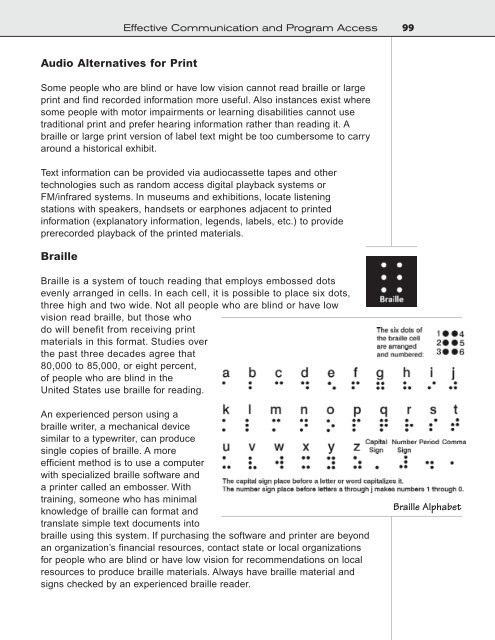Design for Accessibility: A Cultural Administrator's Handbook
Design for Accessibility: A Cultural Administrator's Handbook
Design for Accessibility: A Cultural Administrator's Handbook
Create successful ePaper yourself
Turn your PDF publications into a flip-book with our unique Google optimized e-Paper software.
Effective Communication and Program Access 99<br />
Audio Alternatives <strong>for</strong> Print<br />
Some people who are blind or have low vision cannot read braille or large<br />
print and find recorded in<strong>for</strong>mation more useful. Also instances exist where<br />
some people with motor impairments or learning disabilities cannot use<br />
traditional print and prefer hearing in<strong>for</strong>mation rather than reading it. A<br />
braille or large print version of label text might be too cumbersome to carry<br />
around a historical exhibit.<br />
Text in<strong>for</strong>mation can be provided via audiocassette tapes and other<br />
technologies such as random access digital playback systems or<br />
FM/infrared systems. In museums and exhibitions, locate listening<br />
stations with speakers, handsets or earphones adjacent to printed<br />
in<strong>for</strong>mation (explanatory in<strong>for</strong>mation, legends, labels, etc.) to provide<br />
prerecorded playback of the printed materials.<br />
Braille<br />
Braille is a system of touch reading that employs embossed dots<br />
evenly arranged in cells. In each cell, it is possible to place six dots,<br />
three high and two wide. Not all people who are blind or have low<br />
vision read braille, but those who <br />
do will benefit from receiving print<br />
materials in this <strong>for</strong>mat. Studies over<br />
the past three decades agree that<br />
80,000 to 85,000, or eight percent, <br />
of people who are blind in the <br />
United States use braille <strong>for</strong> reading.<br />
An experienced person using a <br />
braille writer, a mechanical device<br />
similar to a typewriter, can produce<br />
single copies of braille. A more<br />
efficient method is to use a computer<br />
with specialized braille software and <br />
a printer called an embosser. With<br />
training, someone who has minimal<br />
knowledge of braille can <strong>for</strong>mat and<br />
translate simple text documents into<br />
braille using this system. If purchasing the software and printer are beyond<br />
an organization’s financial resources, contact state or local organizations <br />
<strong>for</strong> people who are blind or have low vision <strong>for</strong> recommendations on local<br />
resources to produce braille materials. Always have braille material and<br />
signs checked by an experienced braille reader.<br />
Braille Alphabet


